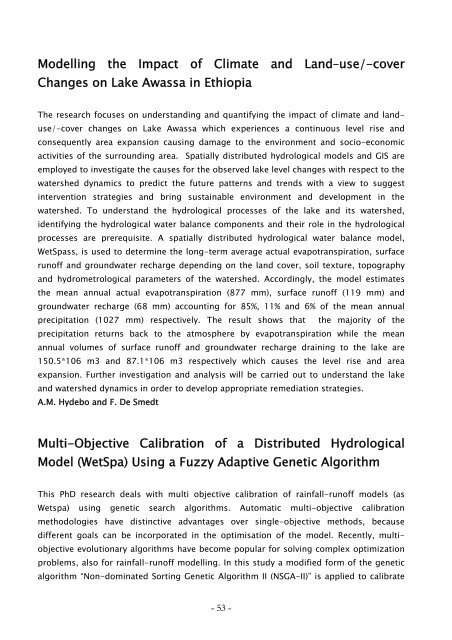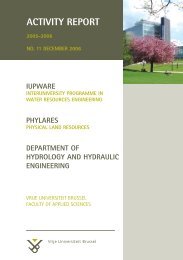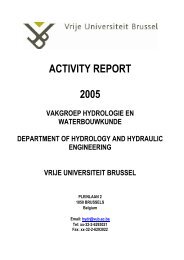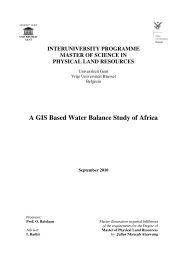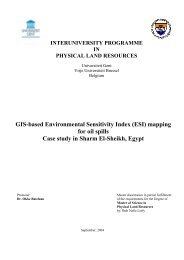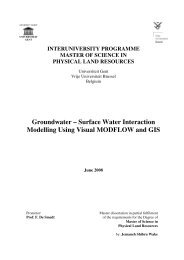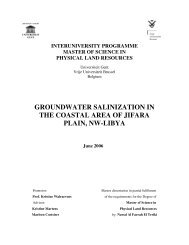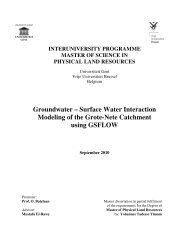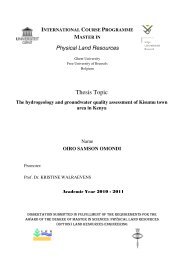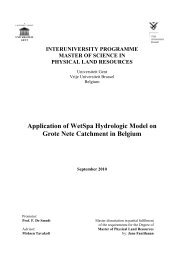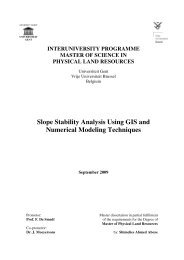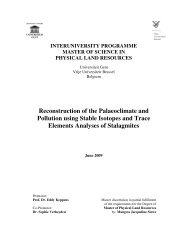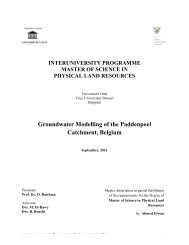C O N T E N T S - Physical Land Resources - Vrije Universiteit Brussel
C O N T E N T S - Physical Land Resources - Vrije Universiteit Brussel
C O N T E N T S - Physical Land Resources - Vrije Universiteit Brussel
You also want an ePaper? Increase the reach of your titles
YUMPU automatically turns print PDFs into web optimized ePapers that Google loves.
Modelling the Impact of Climate and <strong>Land</strong>–use/-coverChanges on Lake Awassa in EthiopiaThe research focuses on understanding and quantifying the impact of climate and landuse/-coverchanges on Lake Awassa which experiences a continuous level rise andconsequently area expansion causing damage to the environment and socio-economicactivities of the surrounding area. Spatially distributed hydrological models and GIS areemployed to investigate the causes for the observed lake level changes with respect to thewatershed dynamics to predict the future patterns and trends with a view to suggestintervention strategies and bring sustainable environment and development in thewatershed. To understand the hydrological processes of the lake and its watershed,identifying the hydrological water balance components and their role in the hydrologicalprocesses are prerequisite. A spatially distributed hydrological water balance model,WetSpass, is used to determine the long-term average actual evapotranspiration, surfacerunoff and groundwater recharge depending on the land cover, soil texture, topographyand hydrometrological parameters of the watershed. Accordingly, the model estimatesthe mean annual actual evapotranspiration (877 mm), surface runoff (119 mm) andgroundwater recharge (68 mm) accounting for 85%, 11% and 6% of the mean annualprecipitation (1027 mm) respectively. The result shows that the majority of theprecipitation returns back to the atmosphere by evapotranspiration while the meanannual volumes of surface runoff and groundwater recharge draining to the lake are150.5*106 m3 and 87.1*106 m3 respectively which causes the level rise and areaexpansion. Further investigation and analysis will be carried out to understand the lakeand watershed dynamics in order to develop appropriate remediation strategies.A.M. Hydebo and F. De SmedtMulti-Objective Calibration of a Distributed HydrologicalModel (WetSpa) Using a Fuzzy Adaptive Genetic AlgorithmThis PhD research deals with multi objective calibration of rainfall-runoff models (asWetspa) using genetic search algorithms. Automatic multi-objective calibrationmethodologies have distinctive advantages over single-objective methods, becausedifferent goals can be incorporated in the optimisation of the model. Recently, multiobjectiveevolutionary algorithms have become popular for solving complex optimizationproblems, also for rainfall-runoff modelling. In this study a modified form of the geneticalgorithm “Non-dominated Sorting Genetic Algorithm II (NSGA-II)” is applied to calibrate- 53 -


